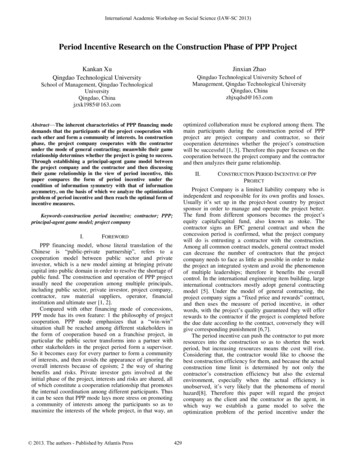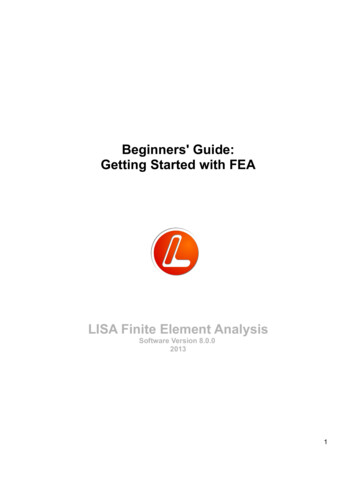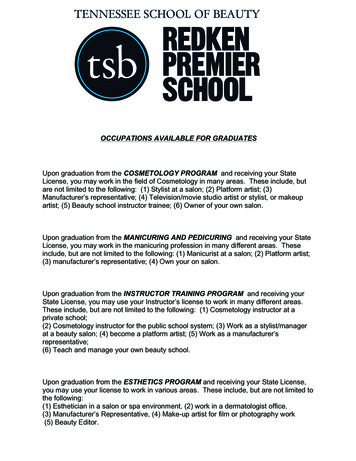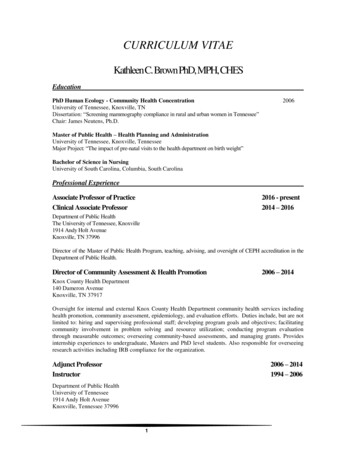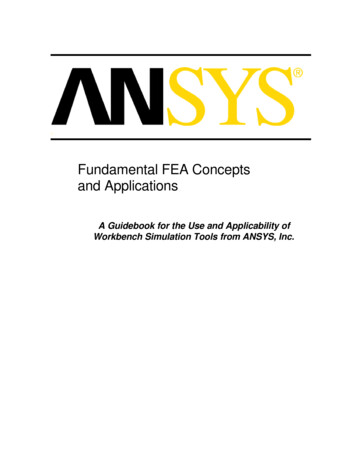
Transcription
Fundamental FEA Conceptsand ApplicationsA Guidebook for the Use and Applicability ofWorkbench Simulation Tools from ANSYS, Inc.
Forward – Demystifying FEA . 2In Perspective . 2What is FEA?. 3Pre-Processing . 3ANSYS Workbench Meshing . 6Solving. 7ANSYS Workbench Solving . 7Post-Processing (Interpretation Of Results). 7ANSYS Workbench Post-Processing . 8Types of Engineering Analysis. 8Stress and Strain – The Basics . 9Users of FEA.10Advanced .10Intermediate.10Fundamental.11In What Areas Can FEA Help?.11Over-Designed Products .11Under-Designed Products.11Miscellaneous Product Performance Issues .12Engineering Assumptions for ANSYS Workbench.12General Assumptions and Limitations .14Assumptions and Limitations Continued .15FEA Terms and Definitions.16FUNDAMENTAL FEA CONCEPTSPAGE 1 OF 46
Forward – Demystifying FEAThere are many high-quality FEA Fundamentals books available, “Building Better Products WithFinite Element Analysis” by Vince Adams and Abraham Askenazi is one such highly recommendedbook (available from Amazon.com). The main purpose of this primer is to provide the reader withenough basic understanding of FEA fundamentals to understand how ANSYS WorkbenchSimulation works with a bias toward how to apply this tool in order to reap the most reward from itsimplementation.A definition of terms, analysis types, assumptions and limitations will be covered and, wheremeaningful, additional explanation as to “Why is this important?” and “How and where would it beused?” will be provided. In addition, a section will cover when to apply ANSYS WorkbenchSimulation and when to look to more advanced tools such as ANSYS Professional or other ANSYSconfigurations that are offer more detailed analysis capabilities but also require more training andexpertise.In PerspectiveFEA, for this discussion, is simply a tool to better understand how a design will perform undercertain conditions. All analysis are approximations accounting for the most significant variablesamong many. What is almost as useful as obtaining an “exact” answer with regard to “reality,”which might take a highly trained specialist a great deal of time performing what is often called a“detailed” analysis, is the trending and behavioral information that can be used to help predict andimprove one’s design (a “basic” or “fundamental” analysis). This approach substantially improvesthe overall engineering process. A very simple example is: how and where does this design bend?Noting how and where parts move can be often be just as helpful as knowing if it moves 1 inch or1.0625, especially early in the design. Accuracy is important and ANSYS is known for quality,accurate products. Within its scope of functionality, ANSYS Workbench Simulation is perfectlycapable of performing detailed analysis on par with traditional FEA methods in a fraction of the time.For any analysis, detailed or fundamental, it is vital to keep in mind the nature of approximations –study the results and test the final design. Proper use of ANSYS Workbench Simulation will greatlyreduce the number of physical tests required while allowing the designer/engineer/analyst toexperiment on a wider variety of design options and improve the end product.Product TerminologyANSYS Workbench in and of itself is not a product, rather it is a product development platform anduser GUI built for analysis needs with the objective of provi ding elegant next generationfunctionality and intelligent automation to the engineering community. Workbench can be thoughtof as a “kernel” from which applications are built in a way similar to how solid modeling kernelssuch as ACIS or Parasolid are used.ANSYS Workbench Simulation is the primary application module used in the Workbenchenvironment and it is available in several product configurations. DesignSpace V6.0 was the firstproduct built and delivered using Workbench technology in September of 2001. Today, theWorkbench Simulation module can invoke any product license available from ANSYSDesignSpace through ANSYS Multiphysics; the higher the license level the more analysiscapability exposed. The term “Workbench Simulation” is used throughout this document and willtypically reference the product DesignSpace but may also reference functionality only availablewhen using an ANSYS Professional or higher-level license.While other ANSYS Workbench product modules are available (DesignXplorer, DesignModeler,FE Modeler), this document will focus only on the Simulation module, regardless of license levelused.FUNDAMENTAL FEA CONCEPTSPAGE 2 OF 46
What is FEA?Finite Element Analysis is a mathematical representation of a physical system comprising apart/assembly (model), material properties, and applicable boundary conditions {collectively referredto as pre-processing}, the solution of that mathematical representation {solving}, and the study ofresults of that solution {post-processing}. Simple shapes and simple problems can be, and oftenare, done by hand. Most real world parts and assemblies are far too complex to do accurately, letalone quickly, without use of a computer and appropriate analysis software.Pre-ProcessingTo do this, FEA software typically uses a CAD representation of the physical model and breaks itdown into small pieces called finite “elements” (think of a 3-D puzzle). This process is called“meshing.” The higher the quality of the mesh (collection of elements), the better the mathematicalrepresentation of the physical model. The primary purpose of an element is to connect nodes withpredictable mathematical equations based on stiffness between nodes; the type of element usedoften depends upon the problem to be solved. The behavior of each element, by itself, is very wellunderstood. By combining the behaviors of each element using simultaneous equations, one canpredict the behavior of shapes that would otherwise not be understood using basic “closed form”calculations found in typical engineering handbooks. A block (element) with well defined thermal, mechanical, and modal behaviors. Example of a simple part whose structural behavior would be difficult to predict using equations by hand. The same part broken into small blocks (meshed into elements) each with well-defined behaviors capable ofbeing summed (solved) and easily interpreted (post- processed).FUNDAMENTAL FEA CONCEPTSPAGE 3 OF 46
There are many different types and classes of elements, most created for specialized purposes(cable, piping, beams, truss structures, e-mag, etc.). A one-dimensional element represents lineshapes, such as beams or springs. A 2D element, also known as a quadrilateral element, willrepresent triangles and squares. 3D elements represent solid shapes and are usually in 2 basicshapes: brick (hexahedrons or “hex”) and pyramids (tetrahedrons or “tets”).Examples of applications for specialized elements would be: scaffolding consisting of connecting 1Dline elements. Car bodies and other stamped or formed sheet metal parts are typically very thinrelative to their overall size and are usually best represented by 2D shell/plate elements. Many thinshapes can, and are, meshed with 3D solid elements but at the cost of increased processing timeand sometimes a loss in accuracy because of the special formulation of 2D shell elements. Thetradeoff is that, in order to mesh with 2D shell elements, there is often significant modification andpreparation required to the CAD geometry in order to obtain a meshable surface model, or modelsin the case of an assembly. In other words, the pre-processing requirement increases substantially.The guidelines are: can it be meshed and solved in 3D solids (sometimes the resultant model issimply too large)? If yes and the user is not looking for ultimate accuracy but only trending andbehavioral information, then 3D solid meshing is often appropriate due to the human time savings.3D elements are ideal for thick and chunky parts and assemblies such as engine blocks, machinecomponents, etc.General purpose, modern mechanical FEA programs typically use a select set of elements chosenfor their versatility, robustness, and their overall contribution to product ease of use. WorkbenchSimulation uses several primary element types and will default to high-order (10 node quadratic)tetrahedral (H) elements (SOLID 187 in ANSYS-Speak) for solid model geometries if they are notsweepable, in which case high-order (20 node) brick elements (SOLID 186) are employed. Onclosed surface models, “quad-dominate” (4 node) shell elements (SHELL 181), are used providingboth accuracy and efficiency while being suitable for the robust automatic meshing algorithms usedin Workbench Simulation. And, for part-to-part interaction within assemblies, high-end surface-tosurface contact elements (CONTACT 170/174) are used. For mixed beam/shell models and forspot-weld features, beam elements are employed (BEAM 188). ANSYS Workbench Simulationapplies these various element types automatically.FUNDAMENTAL FEA CONCEPTSPAGE 4 OF 46
Common Element Types Used in ANSYS Workbench Simulation 4-Noded Shell10-Noded Tetrahedral20-Noded HexahedralOther Common Element TypesEach element is comprised of 2 or more “nodes” which help define its shape as well as to conveyphysical reactions from one element to the next. The “finite” in FEA comes from the fact that thereare a known number of elements in a finite element model. The solver adds up the individualbehaviors of each element to predict the behavior of the entire physical system.FUNDAMENTAL FEA CONCEPTSPAGE 5 OF 46
Other aspects of the pre-processing phase involve identifying material properties and environmentalconditions the design will be subject to. These conditions include various forms of physical forces(loads, pressures, moments, etc.), thermal loads and conditions (temperature, conductivity,convection, etc.), and constraints (fixed, pinned, frictionless/symmetrical, etc.). Some WorkbenchSimulation pre-processing fundamentals:ANSYS Workbench Simulation MeshingANSYS Workbench Simulation provides 2 forms of automated meshing: Fully automatic andManually Directed Automatic. Both forms employ a fault-tolerant philosophy meaning that, if aproblem occurs, at least 12 attempts of automatic trouble-shooting are made before the mesherfails and tags the area of difficulty with a label. Manually directed means that the user may specifymeshing overrides on specific areas of a part (edge(s), face(s)) or the baseline mesh density onentire parts that differ from other parts within the assembly, either for accuracy or efficiencypurposes. These changes remain associative.Workbench Simulation Material DataStructural and thermal material data are defined, modified, and used in Workbench Simulation forstructural and thermal analyses. Material properties include Young's modulus, Poisson's ratio,density, coefficient of thermal expansion, and thermal conductivity. The latter quantity, conductivity,can be temperature-dependent.Workbench Simulation Convection DataTemperature-dependent film coefficients are defined, modified, and used in Workbench Simulationfor thermal analysis. Many categories of film coefficients can be devised to take into accountlaminar, turbulent, forced, and natural convection conditions, as well as various geometricconfigurationsWorkbench Simulation Fatigue Material DataMaterials in the Workbench Simulation material library may include a fatigue stress-life curvepopulated with data from engineering handbooks. Fatigue data has been pre-populated for theStructural Steel and Aluminum Alloy material data files from the MIL-SPEC handbook (MIL-HDBK5H) (http://analyst.gsfc.nasa.gov/FEMCI/links.html). Since material data is crucial to accuratefatigue results, Workbench Simulation readily allows the input of this information to new or existingmaterials by hand or through load history files. The Fatigue Tool will then use the information in thestress-life curves for each material in the model when calculating life, damage, safety factors, etc.Workbench Simulation Pre-Processing ExtensionsMany additional pre-processing capabilities can be realized by using the ANSYS PreprocessingCommand Builder in which the user has greatly expanded capabilities to modify the analysis.APDL commands can also be added to the command stream to extend capabilities even further.The ANSYS Preprocessing Command Builder is enabled in Workbench Simulation when using anANSYS Professional or higher-level license.More sophisticated analysis types such as fluid flow, Micro Electro-Mechanical Systems(MEMS), and transient (time dependent) have many additional environmental and materialproperty considerations, which require additional expertise to properly employ and are beyondthe scope of discussion here.FUNDAMENTAL FEA CONCEPTSPAGE 6 OF 46
ANSYS Workbench SolvingANSYS Workbench employs 3 of the ANSYS solvers and automatically chooses the mostappropriate or efficient solver for the job at hand. In addition to linear/static, ANSYSWorkbench performs Coupled analysis types (thermal-stress, stress-modal, thermal-stressmodal) as well as some limited non-linear analysis types (thermal with temperature-dependentmaterial properties and convection, geometric/contact with contact supporting lift-off). Allsolver settings and iteration propagations from one solve step to the next are performedautomatically.Post-Processing (Interpretation Of Results)The output of a solver is generally a very substantial quantity of raw data. This quantity ofraw data would normally be difficult and tedious to interpret without the data sorting andgraphical representation referred to as post-processing. Post-processing is used to creategraphical displays that show the distribution of stresses, strains, deformations,temperatures, and other aspects of the model. Interpretation of these post-processedresults is the key to identifying areas of potential concern (weak areas in a model), areasof material waste (areas of the model bearing little or no load), or valuable information onother model performance characteristics (thermal, modal) that otherwise would not beknown until a physical model were built and tested {prototype}. CAD Assembly withLoads and Supports Meshed Assembly (Hexand Tet Elements) Stress Plot of SolvedProblemThe post-processing phase of FEA is where the most critical thinking must take place,where the user looks at the results (the numbers vs. color contours, movements, etc.), andcompares results with what might be expected. It cannot be stressed enough that it is upto the user to determine if the results make sense, to be able to explain the results basedupon engineering “common sense.” If the results are other than expected, one mustsearch until an explanation can be found before the results can be fully trusted.ANSYS Workbench Post-ProcessingA select set of results is available for the user to view and interrogate. The set of results arefundamental stress, strain, deformation, thermal, shape optimization, and fatigue. Interrogationinvolves several options: Scoping: Isolating parts from an assembly, or faces from a part and displaying resultsonly on those areas. Slicing: Drawing a slice plane through any results figure then rotating the model sothat the slice can be seen. Multiple slices through any one figure are allowed, as isthe ability to drag a slice through the part.FUNDAMENTAL FEA CONCEPTSPAGE 7 OF 46
ANSYS Workbench Post-ProcessingA select set of results is available for the user to view and interrogate. The set of results includefundamental stress, strain, deformation, thermal, shape optimization, mode shape, and fatigue.Interrogation involves several options: Scoping: Isolating parts from an assembly, or faces from a part and displaying results onlyon those areas. Slicing: Drawing a slice plane through any results figure then rotating the model so that theslice can be seen. Multiple slices through any one figure are allowed, as is the ability todrag a slice through the part. Probe: Dynamically display the results at cursor tip. Left mouse button allows for “probetags” of results to be displayed on the model. Interactive Legend: Allows user to dynamically change color bands for results display. Deformed Shape: Several settings from undeformed to 5:1 automatic factor deformation.The automatic factor is calculated to ensure a visible deformation in the displayed model,whether the factor is 0.01 or 100.Many additional post-processing plots may be obtained using the ANSYS PostprocessingCommand Builder in which POST1 results are made available. APDL commands can also beadded to the command stream to embed any other desired graph, output, or POST26 results. TheANSYS Postprocessing Command Builder is enabled in Workbench Simulation when using anANSYS Professional or higher-level license.General Types of Engineering AnalysisStructural analysis will be either linear or non-linear. Linear model analysis assumes that thematerial does not plastically deform (permanent deformation). Non-linear models consist ofseparating contact conditions (contact with lift -off), when stressing material past its elasticcapabilities into the plastic range, or bending greater than 10% of model length (large deformation).At this point, material properties change and stresses in the material will vary with the amount ofdeformation. Vibrational analysis is used to test a model for its natural, resonant frequencies (toavoid a rattling muffler during idle conditions, or other failure such as happened with the TacomaNarrows bridge) random vibrations, shock, and impact. Each of these incidences may act on thenatural vibrational frequency of the model, which, in turn, may cause resonance and subsequentfailure.Fatigue analysis helps designers to predict the life of a model by showing the effects of cyclicloading on the part/assembly. Fatigue is responsible for approximately 80% of all structural failures.Heat Transfer analysis shows the conductivity or thermal properties of the model. This may beeither steady state or transient transfer. Steady -state transfer refers to constant thermal propertiesthat yield linear heat diffusion and where time is not a factor in either the loading of thermalproperties or in reading results at various time increments. Non-linear will usually involve time,radiation, and/or changing thermal properties in the material or through convection.Shape optimization considers the physical load paths through a model and categorizes elementsinto 3 load-bearing levels: Significant, Marginal, and Low. If an element carries significant load, itwill not be considered for identification for material removal. Shape optimization is not based onstress results, though it is analogous to some degree: areas of high stress are likely significant loadbearing elements and will not be identified for possible removal. Results are purely visual andconceptual giving the user intuitive clues on where material may be reduced in the model throughuse of his CAD system. Workbench Simulation does not perform the actual material removal.Modified models should still be run through Stress analysis for verification.FUNDAMENTAL FEA CONCEPTSPAGE 8 OF 46
Vibration analysis consists of several types: fundamental or natural frequencies, with or withoutpre-stressing forced vibration, noise-vibration-harshness or randomly induced vibration such aswould be experienced in an earthquake. Workbench Simulation helps determine if a part orstructure is susceptible to environmental vibrations, as with might be experienced with rotatingequipment or other induced vibrations (picture an opera singer breaking a glass, or the TacomaNarrows bridge collapse).Harmonic analysis is used to determine the steady-state response of a linear structure to loadsthat vary sinusoidally (harmonically) with time. The results encompass the structure’s response atseveral frequencies and provide graphs or animations of a response quantity, such as displacementversus frequency. Harmonic analysis is supported in Workbench Simulation when using an ANSYSProfessional or higher-level license.Stress and Strain – The BasicsStress occurs when any physical object is subject to loading and is expressed in the form of Forceper unit area such as PSI for Pounds per Square Inch. There are two fundamental forms of stress:Normal (pulling) and Shear (tearing). Strain is a dimensionless quantity calculated as the ratio ofdeformation to the original size of the body – the amount of stretching that the object undergoes dueto loading.The relationship between stress and strain, and the equations that govern them are shown in thefollowing graph: Basic Engineering Concepts - Stress vs. Strain and Hook's Law.Notice that the first part of the curve is very linear. The slope of this curve is what is defined as theYoung’s Modulus of the material, and is well understood for common material types. In this linearrange, stress and strain are proportional and therefore straightforward to calculate and where theterm “linear stress” comes from.Three dimensional stresses and strains build up in many directions. A common way to expressthese multi-directional stresses is to summarize them int o an “Equivalent” stress, also known as the“Von Mises” stress.FUNDAMENTAL FEA CONCEPTSPAGE 9 OF 46
All objects will have a stress limit depending upon the material used and is referred to as MaterialYield. If steel had a yield limit of 40000 psi, any stresses above this limit would result in some formof permanent deformation. (Notice in the graph above where the stress-strain curves start todiverge, this is the yield limit of the material.)If a design is not supposed to permanently deform by going beyond yield (most cases), then themaximum allowable stress in this case would be 40000 psi. A Factor of Safety can be calculated asthe ratio of the maximum allowable stress to the equivalent stress (Von Mises) and would need tobe over 1 in order for the design to be acceptable (below 1 means there will be some permanentdeformation). In Workbench Simulation, stress templates are provided that automatically calculateboth the stress and sheer Factor of Safety for ductile and brittle materials. Ductile materialsgenerally refer to steel, aluminum, brass, and other like metals that tend to stretch more thanfracture. Brittle materials refer to glass, concrete, cast iron, ceramics, and certain types of hardenedsteels. The factor of safety used for brittle materials in Workbench Simulation is the Mohr-Coulombstress theory.Factor of safety results in Workbench Simulation are very useful since they will immediately pointout areas of potential yield whereas equivalent stress results will always show “red” in the highestarea of stress regardless of how high or low the value. Since a factor of safety of 1 means thematerial is essentially at yield, most designers will strive for a safety factor of between 2-4 based onthe highest expected load scenario. It should also be noted that, unless the maximum expectedload will be frequently repeated, some areas of the design that go into yield does not always meanthe part will fail. One must, as always, use engineering common sense to evaluate the situation.Users of FEAFor the most part, users of FEA may be grouped as advanced, intermediate, or fundamental.AdvancedTraditionally, an analyst (a specialist in FEA) would spend considerable time learning how tocorrectly apply and use FEA software for advanced problems involving non-linear materialproperties (composites, highly elastic, etc.) non-linear geometry conditions (what happens aftermaterial yield and beyond to failure), time conditions (drop tests, crash tests, thermal radiation), anddynamics (earthquake analysis), to name just a few. Typically, an analyst spends most of their timeusing FEA software and very little in a CAD modeling system. Analysts are almost always degreedengineers who do little actual design but are highly regarded within their company for theirexpertise. This user will perform all analysis types from fundamental through advanced. Becauseof their expertise, most of their efforts are spent on advanced analysis, leaving little time forfundamental analysis problems usually encountered by engineers.If a company has a dedicated in-house analyst, then they will normally be consulted during apurchase of up-front simulation tools for fundamental analysis needs. In these cases,Workbench Simulation products (DesignSpace in particular) are approved more often than anyother tool in their class, especially after thorough benchmarking involving real-world assembliesand problems because of the automation, robustness, accuracy, and the ANSYS solversemployed.IntermediateThe intermediate user of FEA is also almost always a degreed engineer who may split his or hertime between product design (with or without CAD) and analysis software solving problems bothintermediate and fundamental. In the scale of users, there are more of these intermediate usersthan there are analysts. ANSYS Workbench Simulation addresses the entire fundamental rangeFUNDAMENTAL FEA CONCEPTSPAGE 10 OF 46
and some of the mid-range of these users needs in the areas of fatigue, manual mesh refinementcontrols, shell meshing, harmonic analysis, and non-linear contact conditions.FundamentalThe bulk of FEA is used for fundamental analysis problems addressed by ANSYS WorkbenchSimulation; linear/static stress, deflection, factor of safety, thermal, and modal. The typical user ofWorkbench Simulation (usually DesignSpace) is an occasional user of FEA, spending most ofhis/her time designing in CAD, and should have good “engineering common-sense.” This user mayor may not be a degreed engineer but must have a good understanding of how the product beingdesigned will be used so that it may be properly simulated. While just about anybody can use thisclass of tools, software cannot replace good critical thinking: Is the product behaving as expected(did I use the right loads/supports)? Are the answers within expected ranges (did I use the propermaterials and unit system)? In short, does it all make sense and how can the results be used toproperly evaluate the design.In What Areas Can FEA Help?Simulation, especially early in the design cycle, can bring dramatic benefits to almost anyengineering discipline, including Product Design, Machine Design, Automotive ComponentDesign, and Aerospace when creating new designs and/or modifying existing designs. Examplesof situations where early design simulation may help:Over-Designed ProductsAlmost all manufactured products from all design disciplines include excessive material of some sortbecause adequate simulation was not done early enough in the concept and design stages toidentify wasted material. If simulation was done at the end of a product design cycle, it may havebeen too late and costly (in time) to change the design and start over.n Costs incurred: For high-volume products, count percentage of material over-use (typically10-15%), any extra shipping/handling charges based on weight, and manufacturingprocesses affected (more efficient tooling may be possible).nAnalysis types: Factor of Safety (is the part 5 or more times over material yield?), Shape(conceptually identify areas of possible material removal), Stress (to verify design, identifyareas of weakness, identify areas of over-design), and Fatigue (product life verification).nExample case study: Home Gardner; saved 20x cost of Workbench Simulation on firstproject alone.Under-Designed ProductsFew of these make it past the first prototype stage and if they do, it bodes ill for the designer and thecompany that produced the product; hence, most products are over-designed. Of course, if adesign does not pass the first prototype stage, that means that at least one more prototype must bemade, and sometimes several.n Costs incurred: Count the cost of each prototype; fabrication costs, personnel time, lostopportunity, increased time to market, lost market share, etc. Each prototype cyclerepresents enormous costs to the company that few like to talk about yet it also representsthe area of highest potential savings .FUNDAMENTAL FEA CONCEPTSPAGE 11 OF 46
nAnalysis types : Factor of Safety (is the part approaching material yield?), Stress (to verifydesign, identify areas of weakness), Deformation (does it bend too much?), Thermal (isenough heat being dissipated, is an area at an unacceptable temperature?) and Fatigue(product life
ANSYS Workbench Simulation is the primary application module used in the Workbench environment and it is available in several product configurations. DesignSpace V6.0 was the first product built and delivered using Workbench technology in September of 2001. Today, the Workbench Simulation module can invoke
